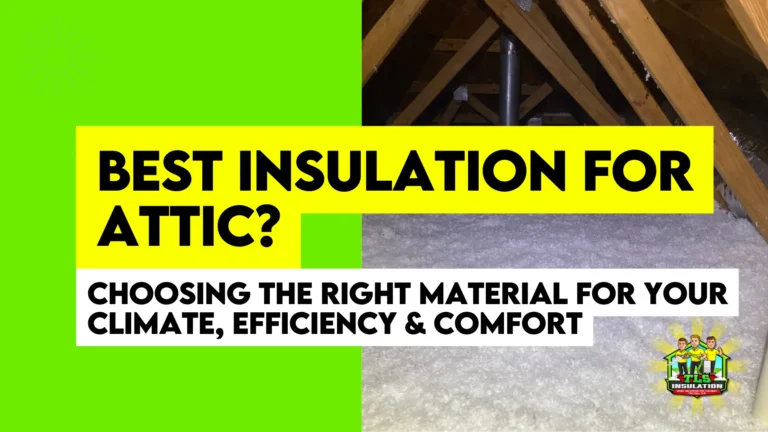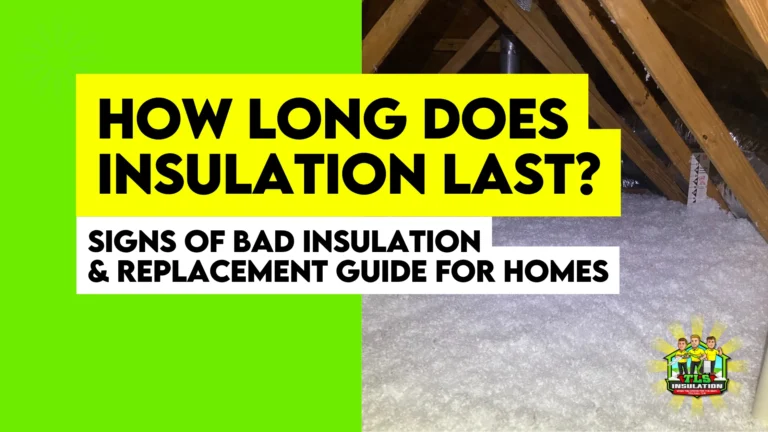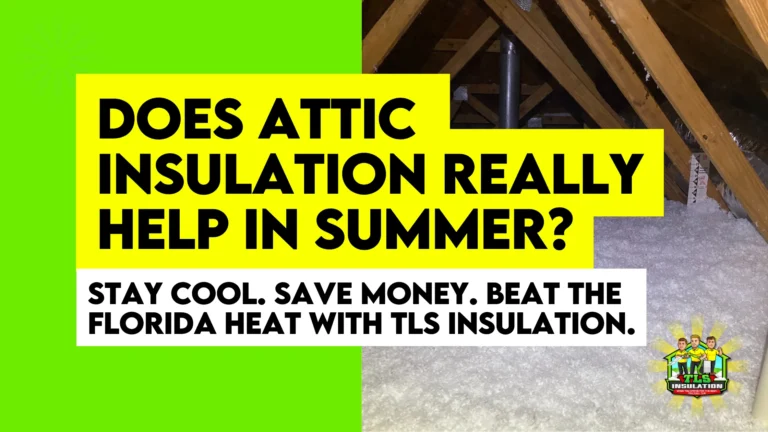Summary: Insulation typically lasts 20-30 years, depending on the material and environmental factors. For homes in hot-humid climates like Florida, insulation lifespan may degrade faster due to moisture and pests. If you notice signs of energy bills or visible damage, it might be time to replace your insulation.
Insulation plays a crucial role in your home’s energy efficiency and comfort, but nothing lasts forever. So how long does insulation last significantly depends on insulation material and other certain factors.
On average, fiberglass insulation lasts around 20-30 years, while spray foam can last 50+ years if maintained properly.
However, in hot-humid climates like Florida (IECC Zone 1A-2A), moisture, salt air, and pests can cause insulation to expire prematurely, reducing its longevity and effectiveness. If your insulation has been in place for over 20 years or shows signs of bad insulation, such as mold, sagging, or moisture damage, it’s time to consider a replacement.
By evaluating how factors like R-value degradation, moisture infiltration, and thermal bridging affect insulation’s efficiency, you can determine the optimal time to replace insulation and ensure your home maintains consistent energy performance over time.
How Long Does Insulation Last – Insulation Lifespan and Performance Analysis
The longevity and efficiency of insulation materials are influenced by factors such as material composition, climatic conditions, and installation quality. In Florida’s hot-humid climate (IECC Zone 1A-2A), insulation materials are subjected to higher moisture levels, which can accelerate degradation and reduce R-value (thermal resistance).
| Insulation Type | Lifespan | Factors Affecting Longevity |
| Fiberglass | 20-30 years | Moisture, settling, pests |
| Cellulose | 20-30 years | Settling, mold, rodent damage |
| Spray Foam | 50+ years | Maintenance, cracking |
| Foam Board | 30-50 years | Moisture damage, wear |
Fiberglass Insulation: Durability and Maintenance
- Typical Lifespan: 20–30 years
- R-Value Retention: Prone to degradation in high humidity
- Maintenance Considerations: Regular inspection for moisture and pest damage
Fiberglass insulation, commonly used in attics and walls, maintains its R-value effectively under dry conditions.
However, in humid climates like Florida, moisture infiltration can lead to sagging and mold growth, compromising its insulating properties. Studies indicate that fiberglass insulation can lose up to 50% of its R-value when exposed to moisture.
So in order to extract maximum lifespan from fiberglass insulation, regular inspections and ensuring proper ventilation can mitigate these issues and extend its lifespan.
Cellulose Insulation: Performance and Sustainability
- Typical Lifespan: 20–30 years
- R-Value Retention: Susceptible to settling and moisture absorption
- Maintenance Considerations: Periodic re-blowing and moisture control
Cellulose insulation, made from recycled paper products, offers an eco-friendly option with a higher R-value than fiberglass.
However, it is more susceptible to settling and moisture absorption, which can reduce its effectiveness.
In Florida’s climate, without proper air sealing and moisture barriers, cellulose can degrade faster, potentially losing up to 20% of its R-value over time. Regular maintenance, including re-blowing and ensuring moisture control, is essential to preserve its insulating properties.
Spray Foam Insulation: Longevity and Efficiency
- Typical Lifespan: On Average 50+ years
- R-Value Retention: Minimal degradation over time
- Maintenance Considerations: Occasional inspection for physical damage
Spray foam insulation, particularly closed-cell variants, provides superior air sealing and moisture resistance, making it highly effective in humid climates like Florida.
Properly installed spray foam can maintain its R-value over time, with minimal degradation.
However, physical damage or improper installation can compromise its performance. Periodic inspections are recommended to ensure its integrity and effectiveness
What is the Insulation Lifespan Across Different Areas of the Home
| Home Area | Insulation Type | Lifespan | Replacement Consideration |
| Attic | Fiberglass, Spray Foam | 20-30 years | High moisture impact in humid areas. |
| Walls | Cellulose, Fiberglass | 20-30 years | Affected by mold and moisture buildup. |
| Crawl Space | Fiberglass, Foam Board | 15-20 years | Susceptible to moisture and pests. |
Apart from Insulation material, Insulation lifespan also varies significantly across different areas of the home due to environmental factors, material degradation, and installation quality.
To be more specific, the attic is the most vulnerable area because it is highly exposed to temperature fluctuations and moisture, especially in hot-humid climates like Florida’s (IECC Zone 1A–2A). Attic insulation bears the brunt of air leakage, leading to condensation and moisture accumulation, which accelerates degradation.
Additionally, poor ventilation and pests contribute to faster deterioration.
On the other hand, wall insulation, while more protected, can still face challenges from moisture and mold, particularly in coastal regions like Florida, where salt air and humidity affect insulation R-values over time.
Crawl space insulation is susceptible to water damage, pests, and moisture seepage from the ground, leading to a shorter lifespan. Understanding these dynamics and the factors that impact insulation longevity is crucial for determining when to replace insulation and how to optimize energy efficiency.
How Long Does Attic Insulation Last: Lifespan, Efficiency, and Maintenance
- Typical Lifespan: 20–30 years, but highly vulnerable to moisture.
- Susceptibility: Moisture infiltration, pest damage, and ventilation issues.
- Maintenance Considerations: Regular inspections, moisture control, and air sealing.
Attic insulation is the most vulnerable area for insulation degradation because it’s a first line of defence against extreme temperature fluctuations, humidity, and moisture. In Florida, where humidity levels can exceed 70%, moisture seeps into fiberglass or cellulose insulation, causing it to lose R-value and efficiency.
Condensation and pest activity further accelerate this process. For example, fiberglass batt insulation can lose up to 50% of its R-value in just 10–15 years if exposed to moisture.
Proper ventilation in the attic is essential to prevent moisture buildup, which can cause mold growth and insulation sagging. Moreover, sealing any air gaps around ducts, pipes, and the roof is crucial to prevent energy loss. Regular inspections for pests, moisture, or sagging insulation are necessary to ensure the insulation’s continued efficiency.
Maintenance Tips:
- Use vapor barriers to control moisture and maintain insulation’s R-value.
- Seal air leaks around ducts, vents, and windows to minimize temperature fluctuations.
- Inspect attic insulation every 3-5 years for signs of moisture damage or mold growth.
How Long Does Insulation Last in Walls: Lifespan, Challenges, and Best Practices
- Typical Lifespan: 20–30 years, with challenges from moisture and pests.
- Vulnerabilities: Mold and moisture accumulation due to external weather conditions.
- Maintenance Considerations: Periodic inspection and moisture control.
Wall insulation, whether fiberglass batt or cellulose, has a typical lifespan of 20–30 years, but its performance is heavily impacted by moisture, air leaks, and settling.
In coastal areas like Florida, salt air combined with high humidity can significantly reduce R-values in wall insulation.
For instance, cellulose insulation tends to absorb moisture, which can cause it to settle and reduce its insulating effectiveness. This issue is compounded in older homes where walls may not have adequate vapor barriers or proper sealing.
Moisture buildup behind walls, especially in bathrooms or kitchens, can encourage mold growth and damage.
Additionally, rodents or insects that infiltrate wall cavities can compromise insulation material integrity. Regular inspections and air sealing are essential to prevent further damage.
Maintenance Tips:
- Ensure proper sealing of wall cavities to prevent air leaks.
- Moisture barriers can prevent water from accumulating behind walls.
- Conduct inspections every 3-5 years for pests and moisture damage
How Long Does Insulation Last in Crawl Spaces: Lifespan, Risks, and Preventive Measures
- Typical Lifespan: 15–20 years, shorter lifespan due to moisture and pest exposure.
- Vulnerabilities: Water damage from ground moisture, pests, and inadequate ventilation.
- Maintenance Considerations: Vapor barriers, dehumidifiers, and regular inspections.
Crawl space insulation is particularly vulnerable to moisture infiltration from the ground, which can significantly reduce its R-value and lead to pest infestations.
The high moisture levels in crawl spaces promote the growth of mold, which accelerates insulation degradation. Insulation like fiberglass or foam board may absorb water, losing its ability to prevent heat transfer effectively.
Proper vapor barriers and the use of dehumidifiers can help mitigate moisture buildup and extend the lifespan of insulation in these spaces. Regular inspections are crucial for identifying signs of rodent activity or water damage.
Without these preventative measures, crawl space insulation may need to be replaced sooner than other types of home insulation.
Maintenance Tips:
- Install vapor barriers and dehumidifiers to prevent moisture damage.
- Regularly check for pest infestations or rodent damage.
- Perform inspections every 2-3 years for moisture buildup and damage.
Does Insulation Go Bad – Signs Of Bad Insulation You Should Keep Your Eyes On
Yes, insulation can go bad over time due to factors like moisture, pest damage, and poor ventilation. And the good news is that bad insulation most of the time clearly shows obvious signs of expiry which you can detect by your own without calling professionals for an inspection.
Fiberglass, cellulose, and other insulation materials lose their effectiveness as they degrade, often due to moisture exposure or physical damage.
When insulation goes bad, it may show signs like wet patches, discoloration, or settling. Identifying these issues early can help homeowners take action before higher energy bills or mold issues arise.
What Are The Signs of Bad Insulation?
Physical Appearance: Discoloration, Wet Patches, and Sagging
- Wet patches from water leaks.
- Discoloration or staining due to mold.
- Sagging insulation indicating loss of R-value.
Bad insulation often starts to show visible signs of deterioration. Fiberglass insulation, for example, can sag or compact over time, especially if exposed to moisture. Cellulose can settle, reducing its R-value.
If you notice wet patches or discoloration in your attic or walls, it’s a clear indicator that your insulation is compromised. Mold and mildew can develop, further degrading the material and potentially impacting indoor air quality.
Environmental Changes: Odors and Moisture Accumulation
- Musty smells from mold growth.
- Damp insulation affecting indoor air quality.
- Humidity buildup leading to rapid deterioration.
Moisture accumulation in insulation often leads to a musty odor or damp smell throughout the house, especially in the attic or crawl space. In areas with high humidity, such as Florida, cellulose insulation can absorb moisture and mold growth may occur.
These odors typically indicate the presence of mold or bacteria inside the insulation, which compromises the thermal resistance of the material. If your insulation smells musty or damp, it’s a strong signal that it needs to be replaced immediately.
Pest Infestation: Insulation Chewed or Torn by Rodents
- Rodent damage: Insulation chewed or torn.
- Pest nests inside the insulation.
- Loss of thermal resistance due to pest activity.
Rodents like rats, squirrels, and other pests often find their way into attics and walls, chewing through fiberglass and cellulose insulation.
Rodent nests in insulation not only damage the material but also reduce its thermal resistance, making it less efficient. Infestation signs include chewed insulation, droppings, or visible damage in the attic or wall cavities.
If insulation is damaged by pests, it’s time to replace insulation and seal any access points to prevent further issues.
How Often Should Insulation Be Replaced?
Insulation typically lasts 20–30 years, but the need for replacement depends heavily on environmental factors. In areas prone to moisture, humidity, or temperature fluctuations, like Florida, insulation can deteriorate faster. If moisture infiltration, pest damage, or mold growth is detected, replacement is necessary much sooner, even if it hasn’t reached its expected lifespan.
Higher energy bills are another key indicator that insulation is underperforming. Over time, insulation loses its thermal efficiency, requiring more energy to regulate indoor temperatures. If air leaks, pest damage, or moisture is causing insulation to fail, upgrading to a higher-performance insulation like spray foam may offer better long-term energy savings.
When Should You Replace Insulation?
- 20–30 years is the typical lifespan for most insulation types, but environmental factors can shorten this.
- Moisture and mold growth are key indicators that insulation needs to be replaced immediately.
- Pests (e.g., rodents) can cause physical damage to insulation, compromising its R-value.
- If air sealing is compromised, energy efficiency will decline, prompting a need for upgrades.
Upgrading Insulation for Better Energy Efficiency
If you find that your insulation has settled, compressed, or become ineffective, it might be worth upgrading to spray foam insulation. Spray foam offers superior air sealing properties and has a much higher R-value compared to fiberglass or cellulose, making it a more energy-efficient option in the long term.
Expert Advice to Follow
To ensure your home’s insulation remains effective, schedule regular local inspections. Professional inspectors can evaluate the R-value, moisture levels, and pest issues that affect insulation. This will help you determine whether you need to replace insulation or simply maintain it for a few more years.
How to Maintain Insulation for Longer Lifespan
Yes, the lifespan of insulation can be increased through proactive care and maintenance. By addressing key factors like moisture control, air leaks, and pests, you can slow down the natural degradation of insulation materials like fiberglass, cellulose, or spray foam. Regular attention ensures your insulation retains its R-value and continues to provide efficient thermal resistance.
Actionable Tips to Extend Insulation Lifespan:
- Seal Gaps Around Windows and Doors: Air leaks around windows and doors allow heat to escape, causing insulation to work harder and degrade faster. Use caulk or weatherstripping to seal gaps and prevent air infiltration.
- Ensure Proper Ventilation in the Attic and Crawl Spaces: Lack of ventilation traps moisture and promotes mold growth, which compromises insulation. Install soffit vents and ridge vents to enhance airflow, preventing humidity buildup.
- Inspect for Moisture Regularly and Address It Promptly: Moisture is the primary cause of insulation degradation. Inspect attics and crawl spaces for water leaks, condensation, or mold. Use dehumidifiers to control humidity and ensure vapor barriers are intact to protect insulation from moisture damage.
Frequently Asked Questions (FAQs)
Does Insulation Expire?
Insulation doesn’t technically “expire,” but it can lose its effectiveness over time. Factors like moisture, settling, and pest damage can degrade its R-value, making it less efficient at regulating temperature.
Does Insulation Lose R-Value Over Time?
Yes, insulation can lose R-value as it settles, absorbs moisture, or gets compressed. Fiberglass and cellulose insulation can lose up to 25% of their R-value over the years due to moisture exposure or pest damage.
Is Replacing Insulation Worth It?
Replacing insulation is worth it if your home experiences higher energy bills, moisture damage, or poor temperature control. Upgrading to more efficient materials like spray foam can provide long-term energy savings and improve indoor comfort.
How to Tell if Attic Insulation is Bad?
Signs that attic insulation is bad include wet patches, discoloration, or sagging. If you notice mold growth or increased energy bills, it’s likely time to replace your attic insulation to restore efficiency.
Pink Insulation Turned Black: What Does It Mean?
Pink insulation turning black often indicates moisture exposure, leading to mold or mildew growth. This reduces the R-value and effectiveness of the insulation, making it necessary to replace it for better energy efficiency and air quality.





